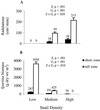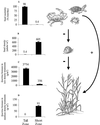A trophic cascade regulates salt marsh primary production
- PMID: 12149475
- PMCID: PMC124954
- DOI: 10.1073/pnas.162366599
A trophic cascade regulates salt marsh primary production
Abstract
Nutrient supply is widely thought to regulate primary production of many ecosystems including salt marshes. However, experimental manipulation of the dominant marsh grazer (the periwinkle, Littoraria irrorata) and its consumers (e.g., blue crabs, Callinectes sapidus, terrapins, Malaclemys terrapin) demonstrates plant biomass and production are largely controlled by grazers and their predators. Periwinkle grazing can convert one of the most productive grasslands in the world into a barren mudflat within 8 months. Marine predators regulate the abundance of this plant-grazing snail. Thus, top-down control of grazer density is a key regulatory determinant of marsh grass growth. The discovery of this simple trophic cascade implies that over-harvesting of snail predators (e.g., blue crabs) may be an important factor contributing to the massive die-off (tens of km(2)) of salt marshes across the southeastern United States. In addition, our results contribute to a growing body of evidence indicating widespread, predator regulation of marine macrophyte production via trophic cascades (kelps, seagrasses, intertidal algae).
Figures



References
-
- Carpenter S. R. & Kitchell, J. F., (1993) Trophic Cascades in Lakes (Cambridge Univ. Press, Cambridge, U.K.).
-
- Power M. E. (1992) Ecology 73, 733-746.
-
- Bertness M. D. (1984) Ecology 65, 370-381.
-
- Paine R. T. & Vadas, R. L. (1969) Limnol. Oceanogr. 14, 710-719.
-
- Paine R. T. (2002) Science 296, 736-739. - PubMed
Publication types
MeSH terms
LinkOut - more resources
Full Text Sources
Other Literature Sources
Research Materials

